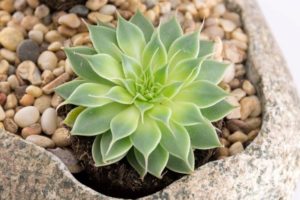In the arid climate of Colorado, water conservation is a constant and worthy concern for homeowners. One of the best ways to conserve water is to plan your landscaping to look beautiful without the need for frequent or extra irrigation.
All plants need some water to survive, and you may feel as though you can’t have a beautiful landscape without lush grass, flowers, and trees. However, with clever design and a few handy tips, you’ll be able to have all the beauty you want without using a ton of water to maintain your yard. Here are some tips for planning a drought-friendly landscape.
- Say No to Grass
The first (and most impactful) area in which to reduce water use is the lawn. American lawns use more space and water than all of the crops (including fruit trees) in the country combined. Watering lawns in the summer can account for half to three-fourths of household water usage. In dry areas without normal rainfall, this number increases.
You can choose an alternative lawn for your outdoor space to conserve the gallons needed daily to keep grass healthy during hot summer days. Consider using:
- Fake grass. If you have only a small space to worry about, a realistic-looking turf product is a feasible option. Keep in mind that turf always looks green, so it can contrast with the lawns of neighbors who have brown grass. If you’re concerned about appearances, keep turf in areas with defined borders, like a backyard or as part of a larger hardscape.
- Rocks. Celebrate the natural beauty of the Colorado landscape by choosing rocks from local sources. Fill areas that would normally by dedicated to lawn with crushed rock. You can add interest by choosing different sizes and colors of stones for a more intricate pattern.
- Hardscapes. Similar to choosing loose rocks, you could also fill in the typically grassy places with large areas of flagstone or paving bricks. Potted plants and grasses are what bring life to hardscapes.
- Wood chips or mulch. Some mulches are made from recycled tires while others are made of insect-resistant pine and cedar bark. Mulch provides a nice template for planting native drought-resistant plants.
Talk to your landscaper about alternatives to grass. The added benefit of having no lawn is reduced maintenance and fewer troubles with patchy coloration and weed infiltration. If you’re worried about going completely grass free, consider planting ornamental grasses as shrubs. These use less water and are quite hardy during low-water conditions.
- Embrace Succulents
Unlike other greenery, succulents thrive in high heat and fully sunny conditions. Like cacti, succulents have waxy exteriors that allow for extreme water conservation. Succulents look regal in terra cotta pots or reclaimed wood box gardens. Succulents come in many varieties and colorations, so you can plant a diverse garden with different sizes and shapes.
Some succulents, like the portulaca, produce beautiful flowers. Others have large foliage, almost mimicking the cactus, except without spines. Agave plants, for example, have a lovely sage color and a shrub-like appearance that looks beautiful in a mulch bed.
As an added bonus, succulents can grow in limited space, and they do not need transplanted out of pots. With a variety of plants, you can rearrange your landscape easily by moving the succulents around to suit your current tastes.
- Choose Native Trees
The best way to ensure your garden and yard conserve water is to choose plants that have always thrived in Colorado, especially when it comes to trees. Trees need a lot of water during their first years of life, and some require constant moisture. For example, willows and birches must have constant access to moisture for healthy growth.
If water conservation is your desire, steer away from hydrophilic species and look instead at the trees the state is most famous for, including:
- All varieties of pine, Colorado blue spruce, and some firs. Colorado is a unique blend of desert and mountain, with evergreens taking the landscape by storm. The needles will not kill your grass if you do not have a lawn, and these trees provide interest during winter months.
- Rocky Mountain maple trees. These trees are hardy compared to other maples. Unlike cottonwoods and alder trees, these maples still thrive in arid soils, provided they also get moisture from seasonal changes.
- Gambel oaks. One of the hardiest deciduous trees, this sturdy oak persists in even the lowest-moisture areas. A slow-growing, deep root system provides the tree with a long life span. The branches are visually interesting, and the unique foliage can be a focal point in a larger backyard.
- Chokecherries. These bush-like trees provide deep red fruit that can appeal to birds and other wildlife. Chokecherries do prefer moist soil, but they can still survive in a variety of conditions.
Choosing native trees also helps to preserve the unique and beautifully rugged state landscape. For more information on water-conserving landscapes, contact us at Schulhoff Tree & Lawn Care, Inc.

